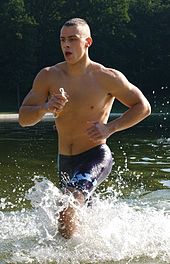Physical fitness: Difference between revisions
BOT--Reverting link addition(s) by Tim1212 to revision 473004072 () |
|||
| Line 78: | Line 78: | ||
* [http://www.healthierus.gov/exercise.html HealthierUS.gov Official website] |
* [http://www.healthierus.gov/exercise.html HealthierUS.gov Official website] |
||
* [http://www.fitness.gov/ President's Council on Physical Fitness] |
* [http://www.fitness.gov/ President's Council on Physical Fitness] |
||
* [http://www.typhoon42.com/ A look at current weight loss methods] |
|||
{{DEFAULTSORT:Physical Fitness}} |
{{DEFAULTSORT:Physical Fitness}} |
||
[[Category:Exercise]] |
[[Category:Exercise]] |
||
Revision as of 23:56, 25 January 2012
The examples and perspective in this article may not represent a worldwide view of the subject. (June 2011) |

Physical fitness comprises two related concepts: general fitness (a state of health and well-being), and specific fitness (a task-oriented definition based on the ability to perform specific aspects of sports or occupations). Physical fitness is generally achieved through correct nutrition, exercise, and enough rest.
In previous years[when?], fitness was commonly defined as the capacity to carry out the day’s activities without undue fatigue. However, as automation increased leisure time, changes in lifestyles following the industrial revolution rendered this definition insufficient. In current contexts, physical fitness is considered a measure of the body’s ability to function efficiently and effectively in work and leisure activities, to be healthy, to resist hypokinetic diseases, and to meet emergency situations.
Fitness

The President's Council on Physical Fitness and Sports—a study group sponsored by the government of the United States—declines to offer a simple definition of physical fitness. Instead, it developed the following chart:[1]
| Health related | Skill related | Sports | |
|---|---|---|---|
|
|
|
A comprehensive fitness program tailored to an individual will probably focus on one or more specific skills,[2] and on age-[3] or health-related needs such as bone health.[4] Many sources[citation needed] also cite mental, social and emotional health as an important part of overall fitness. This is often presented in textbooks as a triangle made up of three points, which represent physical, emotional, and mental fitness. Physical fitness can also prevent or treat many chronic health conditions brought on by unhealthy lifestyle or aging.[5] Working out can also help people sleep better. To stay healthy it is important to engage in physical activity.[6]
Training
Specific or task-oriented fitness is a person's ability to perform in a specific activity with a reasonable efficiency: for example, sports or military service. Specific training prepares athletes to perform well in their sports.
Examples are:
- 400 m sprint: in a sprint the athlete must be trained to work anaerobically throughout the race.
- Marathon: in this case the athlete must be trained to work aerobically and their endurance must be built-up to a maximum.
- Many fire fighters and police officers undergo regular fitness testing to determine if they are capable of the physically demanding tasks required of the job.[7]
- Soldiers of the United States Army must be able to pass the Army Physical Fitness Test (APFT).[8]
See also
- Powerlifting
- Bodybuilding
- CrossFit
- CPR
- Exergaming
- Harvard Step Test
- Health club
- National Academy of Sports Medicine
- Neutral spine
- Obesity
- Personal Trainer
- Physical exercise
- Physical fitness test
- VO2 max
- Olympic Games
References
- ^ "President's Council on Physical Fitness and Sports Definitions for Health, Fitness, and Physical Activity".
- ^ "Skill-related physical fitness essential for sports success".
- ^ "The elderly have specific fitness requirements".
- ^ "A targeted fitness program can increase Bone Integrity".
- ^ "US Department of Health and Human Services Presentation: Physical Activity Fundamental to Preventing Disease".
- ^ "How much physical activity do adults need?".
- ^ "Physical Fitness requirements for Santa Clara County firefighters".
- ^ "APFT Requirements".
9. ^"n.p. (2004, September 21). "The Benefits of Physical Activity." Medical News Today. Retrieved from http://www.medicalnewstoday.com/releases/13772.php."
- Brandon, Leigh (2009). Anatomy of Strength and Fitness Training for Speed. McGraw-Hill. ISBN 978-0-07-163363-5.
